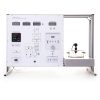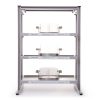NTC-22.05.17 “Studying the induction heating”
Br0.00
The educational laboratory stand is designed for use as training equipment in higher education, secondary specialized, and vocational technical institutions during laboratory and practical sessions on studying the processes of heating liquids in containers with various wall characteristics and investigating the energy parameters of inductive heating of liquids.
*For additional information, you can contact us using the phone numbers or email provided on the website.
 Русский
Русский



